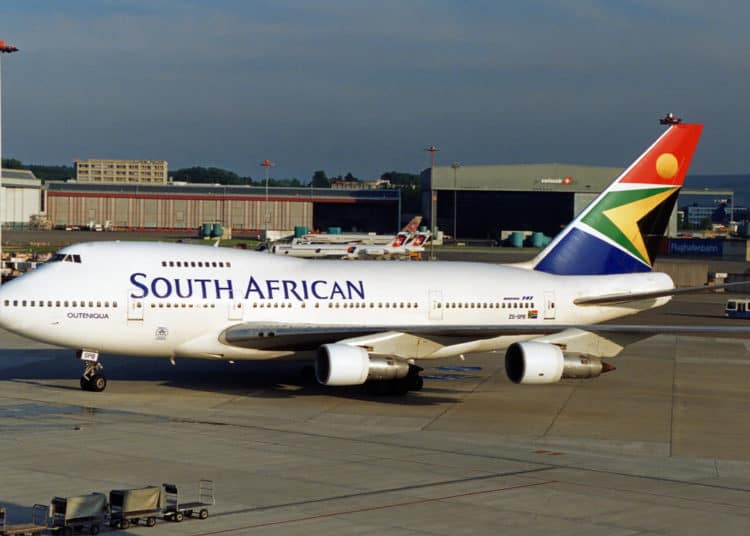Why SAA’s network cuts prove painful to implement


One thing perennial struggler South African Airways has not been short of over the years is restructuring plans. Its latest, proposed under formal restructuring, features a further retrenchment that continues the paring back of its network.
But the ability to achieve the cuts required – and find a model sustainable enough to secure its long-sought objective of attracting private investors – remains challenged by the political desire for the airline to provide connectivity.
SAA has been gradually downsizing over recent years, including under a major network restructuring in 2017 that cut capacity operated in its own right by almost a third. The latest plans, including the scrapping of eight international destinations and all bar one of its domestic services, would see SAA this summer flying around half the capacity it did in the summer of 2015, Cirium schedules data shows.
The latest cuts, which are due to take effect from the end of February, are the most tangible action since the airline was put under business rescue practitioners in early December.
Details of the network cuts came after SAA at the end of January secured offers from a financial institution to provide the additional critical funding necessary to bridge the period until its business rescue plan is adopted.
“Restructuring of SAA will provide an opportunity to develop a sustainable, competitive and efficient airline, with a strategic equity partner remaining the objective of government through this exercise,” SAA says.
POLITICAL CHALLENGES REMAIN
But South African president Cyril Ramaphosa quickly provided a reminder of the political challenges facing the loss-making carrier, when he was quoted as saying that he did not agree with the cuts and was seeking discussions with the administrators.
Les Matuson and Siviwe Dongwana, joint business rescue practitioners for SAA, said in a statement carried in South African media that the decisions were taken in the best interests of the carrier.
“They are intended to make the airline commercially and operationally sustainable, free from the requirement of future funding from the Government post the implementation of the restructure,” they say, noting the actions are aimed at improving SAA’s balance sheet to ensure that the company is ”more attractive” for potential strategic equity partners.
”We recognize the concerns raised, especially around the domestic routes. We will continue to engage with stakeholders, with a commitment to include inputs into the final business rescue plan, which is due to be published by the end of this month.”
Airline managers at SAA have historically found it difficult to push through cuts amid the political dimension to the carrier. Efforts, for example, to drop its loss-making long-haul flights to Beijing and Mumbai were initially floated in 2013 but did not come to fruition until 2015 when alternative partnership arrangements were in place.
Continuity has also been harder to achieve against a backdrop of multiple changes in leadership – several of its chief executives serving in an acting capacity – and boardroom and political battles over the national carrier. Incumbent chief executive Zuks Ramasia has been acting in the role since the summer departure of Vuyani Jarana. The latter, who was SAA’s first permanent chief executive for three years, resigned less than two years after taking the role.
CATALYST FOR CHANGE
SAA’s dire financial position does appear to provide the necessary headroom to push through further network changes. At the start of October last year, South Africa’s public enterprise minister told the national parliament that SAA – as well as state-owned regional carrier SA Express – were not going concerns. Two months later, the carrier’s reputation was further hit as the government conceded there was no option but to begin formal restructuring.
SAA is already streamlining its fleet, putting more than half of its Airbus A340s and a variety of spare parts up for sale – a decision SAA chief Ramasia says was planned with the arrival of its new A350 aircraft. Ironically, in amongst the turmoil, SAA has been able to update its fleet by leasing in four new A350s.
It is the route cuts – especially in the domestic market – that are proving contentious. SAA is stripping back its domestic operations to just one route: the biggest domestic market of Johannesburg-Cape Town. Even that sole-surviving route will be operated on a reduced basis. SAA will also stop operating its own flights on services linking Johannesburg to Durban, East London and Port Elizabeth.
Its franchise partner, privately-owned South African carrier Airlink, is taking on the Port Elizabeth route – one of four services SAA is discontinuing that Airlink will pick-up in its own right. Airlink, which will also fly the Entebbe, Ndola and Luanda flights being dropped by SAA, had earlier in January struck a fresh agreement with the business practitioner to replace a franchise agreement with a new commercial deal.
SAA had already in previous restructurings moved a chunk of its domestic capacity out of its mainline operation to its low-cost unit Mango. The latter’s domestic operations continue, with Mango not impacted by SAA’s move into business rescue, though rival carriers have shown interest in the carrier if the unit should be one of the assets made available for sale as part of SAA’s business rescue.
”To improve the airline’s liquidity, rationalisation programmes are under consideration for SAA’s subsidiaries, as well as the sale of selected assets,” the administrators saying, adding they are continuing ”to explore viable investment opportunities with potential investors in respect of SAA”.
On long-haul, SAA will now operate to just five destinations. The dropping of Munich will see SAA focus in Europe on flights to London Heathrow and the Frankfurt hub of its Star Alliance partner Lufthansa. The shift away from European routes over the past 15 years is evident, with SAA having dropped Paris, Milan and Zurich flights, as well as Cape Town links to Heathrow and Frankfurt over that period.
| SAA intercontinental routes 2005-2020 | ||
| Origin | Destination | Status |
| Johannesburg | Frankfurt | ongoing |
| Johannesburg | London Heathrow | ongoing |
| Johannesburg | New York JFK | ongoing |
| Johannesburg | Washington* | ongoing |
| Johannesburg | Perth | ongoing |
| Johannesburg | Sao Paulo Gaurulhos | to close 29 Feb 2020 |
| Johannesburg | Hong Kong | to close 29 Feb 2020 |
| Johannesburg | Munich | opened 2007, to close 29 Feb 2020 |
| Johannesburg | Guangzhou | was to open Jan 2020, now scrapped |
| Johannesburg | Abu Dhabi | opened 2015, closed 2016 |
| Johannesburg | Beijing | opened 2012, closed 2015 |
| Johannesburg | Mumbai | closed 2015 |
| Johannesburg | Buenos Aires | opened 2009, closed 2014 |
| Cape Town | London Heathrow | closed 2012 |
| Cape Town | Frankfurt | closed 2008 |
| Johannesburg | Paris Charles de Gaulle | closed 2007 |
| Johannesburg | Zurich | closed 2007 |
| Johannesburg | Milan Malpensa | closed 2005 |
| Source: Cirium schedules data. Note: *Served via Accra, previously Dakar |
Moves to direct more capacity to Asia have faltered. The airline plans to cut Hong Kong flights at the end of February and has scrapped the launch of a Guangzhou service – which was planned for launch in September but was pushed back to early this year. It does not specify to what extent the recent challenges in the region – unrest in Hong Kong and the coronavirus outbreak – have played a part in the decision. Having already cut Beijing and Mumbai, it leaves SAA serving just Perth in Asia-Pacific.
It retains services to New York JFK and Washington, but Sao Paulo flights are being cut from the end of February. The carrier had previously also dropped its service to another Latin American destination, Buenos Aires.
While its pan-African services do not escape the cuts – four routes are being dropped – its regional network remains the mainstay of the carrier route map, where it serves 13 destinations from Johannesburg.
RIVAL CHALLENGES
But SAA is not alone among South African carriers facing challenges. Notably, SA Express, which has endured a torrid period including a temporary grounding in the summer of 2018, has now been ordered to follow SAA into a formal business rescue.
While the business rescue has been instructed by a court, the judgement is being appealed by the airline. SA Express, which operates a route network in southern Africa using a fleet of Bombardier CRJs and Q400s, argues that the court “went over and above” the measures required and granted orders which were “not sought” by the applicant.
SA Express had recently complained that it had been struggling to retrieve payments it claims are owed by SAA.
SA Express chief executive Siza Mzimela – herself a former head of SAA – noted at the end of January that a “bleak economic forecast” is continuing to affect businesses in the country. The IMF in January cut its GDP projections for South Africa for this year and next to just 0.8% and 1.1% respectively, and cites challenges for the country’s economy including subdued growth, rising debt, high poverty and unemployment rates.
“Our industry, in particular, is under much scrutiny as even more pressure is being exerted on government-owned airlines such as SA Express, whose validity of existence is increasingly questioned,” she says. But Mzimela insists that SA Express is playing a “critical role” by providing access to smaller markets.
While South African carrier Comair – which operates British Airways franchise flights and the Kulula low-cost brand – has an altogether more impressive record of profitability, it too has faced challenges. There has been a complete refresh of its board of directors, after some shareholders raised corporate governance concerns at its AGM in October.
At an operating level, Comair has warned its earnings per share for the first six months of its financial year – running to December 2019 – are likely to be more than 20% down on the same period last year. The carrier cites the continued impact of the grounding of the Boeing 737 Max. It had one in service at the time of the grounding and has another seven on order. It has also incurred additional costs from transitioning maintenance of its fleet from SAA Technical to Lufthansa Technik.
Another private carrier, Airlink is in the process of starting flights in its own right – having operated under a franchise agreement for SAA. While a new commercial deal keeps SAA as an “important strategic pillar in Airlink’s strategy”, the carrier notes it gives it the freedom to extend its commercial reach, develop more routes and frequencies on an independent basis, and extend or establish additional agreements with other airlines.
Airlink had previously been blocked in it efforts to secure a merger with South African low-cost operator FlySafair. The latter has been the fastest-growing operator in the South African domestic market over recent years. Both have indicated their interest in exploiting opportunities resulting from SAA’s restructuring.
Culled from FlightGlobal







